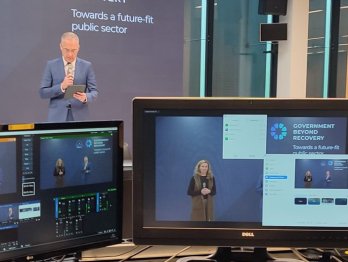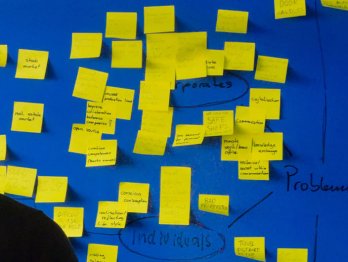COVID-19: Innovative responses update #7

This is our seventh update about innovative responses (including public sector innovation, digital government or open government) being undertaken around the world. Thank you again to all who have contributed in answer to our call and to our partners (including the Centre for Public Impact and GovInsider) for helping us to collect innovative practices. We hope that teams around the world can learn from each other and take inspiration from the information collected. There are now over 300 examples and initiatives in the collection, helping deepen our knowledge and understanding of how the public sector and its partners are responding to one of the most significant crises of recent times.
What can we observe from the additions made since our last update?
- Infection control or tracking measures: Serbia created a ‘National COVID-19 Integrated Information System’ to aggregate and report on data about infections in the country. Serbia also created a service for those who have been cured of the virus and who can donate blood plasma to help others. Meanwhile the City of Tokyo created an open source site to provide real time data on the disease, and Singapore created a tracing app to help contact tracing.
- Improving communications/providing targeted information: in Canada some of the Provinces created self-assessment tools including Alberta, Nova Scotia and Ontario to help people determine whether they need to be tested, something also done in Serbia. The Government of Canada also created a ‘find financial help’ tool for helping people understand what benefits they might be eligible, while in the US, the State of New Jersey created an ‘Emergency Assistance Eligibility Wizard’ to assist people in finding available emergency assistance programmes. Elsewhere, Serbia established a COVID-19 information chatbot on the Viber platform.
- Service delivery in a crisis/adjusting to context: in order to support disadvantaged students with distance education, Serbia formed a coalition with the private sector and provided smart phones, tablets and internet for 2 800 eight-graders coming from disadvantaged families. Serbia also enabled full electronic registration of children in preschool institutions through an eGovernment Portal, eKindergarten 100 and undertook a range of measures to support distant learning.
- Social solidarity and ‘caremongering’: in Spain the #YoHagoPorTi campaign was launched, aimed at promoting behaviours that foster solidarity with the neighbours who need it most: elderly, sick or disabled people. In Serbia a ‘Digital Solidarity Portal’ was created to improve the quality of life to all those who are staying at home due to the corona virus pandemic, including free resources from companies. This was combined with a ‘Be a Volunteer’ platform, which allowed people to volunteer to help older fellow citizens and other at-risk population groups.
- Leveraging and redeploying existing resources and solutions: originating in Canada, but now a global initiative, #findthemasks is a global mapping tool and interactive directory for personal protective equipment (PPE) to enable individuals, communities, makerspace networks, and large-scale manufacturers to help frontline healthcare and other essential workers. Also in Canada, the GC Talent Reserve initiative is a dedicated, single-window coordinated talent management tool for triaging digital and tech talent needs across the Government of Canada during the crisis.
- Open calls, hackathons and other challenge-mechanisms: Brazil’s National School of Public Administration launched a series of challenges relating to the pandemic, including efficiency of the health system and mitigating the socio-economic consequences.
- Collective learning and sense-making: in Finland the Lockdown Dialogues offer citizens and communities the possibility for constructive dialogues during the strains of the lockdown and help to build an understanding of what it is like to live in a world under these unusual circumstances.
- Structural responses and possible longer-term shifts: in Singapore one of the hospitals created a dedicated emergency response healthcare centre to act as a point of coordination, and using big data and AI to predict demand for services. The City of Bristol in the UK has decided to transform parts of its historic Old City area into fully pedestrianised zones, not only in response to the pandemic but also with an eye to the longer term. Meanwhile, the City of Hangzhou in China has announced plans to use their health code app from their coronavirus response in future public health plans including to develop individual rankings, scoring citizens based on indicators including medical records, physical test results, level of activity and other lifestyle choices, giving a colour-coded score out of 100.
Reflections and new thinking
While collecting innovative responses, we are simultaneously keeping an eye on the long term. One of the goals for the Gov After Shock event we are hosting in November is to bring people together to make sense of changing and potential practices, connecting short term tactics and long term strategy. Which innovative responses do we want to keep, scale, and adapt to new contexts? Which are important to the evolving governance context?
And we will, certainly, need to make sense of the buzz. In the last week we’ve seen the view of the “pandemic as a portal,” an opportunity to step into a new world. That new world could include cementing Mariana Mazzucato’s increasingly accepted paradigm of the public sector being central to innovation. Or combining that concept with a revised set of economic goals that focuses on the space where human need and environmental sustainability are both managed (“doughnut economics”). Economist Armine Yalniznan has called for a “She-covery” approach to economic rebuilding that brings the importance of childcare to the forefront, a need which more people have experienced viscerally since March.
Meanwhile, companies and universities are announcing virtual-first approaches ranging from “for a year” to “forever,” changing relationships between people and institutions. This could also go in other directions; observers are calling for a full rethink of the contract between the workforce and corporations, invoking the reduction in average hours that followed historical economic events. Is now the time for four-day work weeks or reduced average hours? With or without government support?
And in the UK the London South Bank University asked those in the NHS what they want to keep from the experience of responding to the pandemic, including the perspective “Our top priority after this is not going back to normal, but going back to better.”
Caveat
The innovative initiatives here are represented as best as we can, given the information available. Additionally, these examples are included as observations, with no judgement made about their merits. Innovative responses are, by definition, new, and it takes time to know whether new things work, and if they work, whether they are appropriate or wanted.
If you know of other examples, we want to hear from you
We need your help in continuing to add innovative initiatives to the coronavirus crisis to our tracker and in disseminating the call. This not only helps us to gather data to inform our research and support of governments, but it helps others to share ideas and replicable solutions with others around the world. All our work on this topic will feed into the broader work of the OECD in compiling data, information, analysis and recommendations regarding the health, economic, financial and societal challenges posed by the impact of Coronavirus (COVID-19). Please visit the dedicated page for a full suite of coronavirus-related information.









